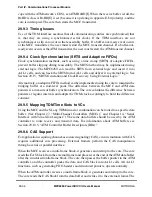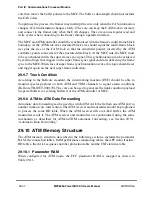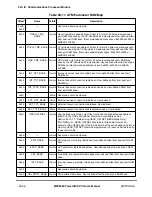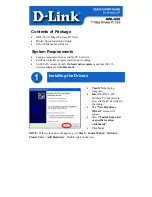
29-36
MPC8260 PowerQUICC II UserÕs Manual
MOTOROLA
Part IV. Communications Processor Module
cope with the ATM networkÕs CDV), set ATM RxBD[I]. When the receive buffer is full, the
RxBD is closed, RxBD[E] is set (because it is operating in opposite E-bit polarity), and the
core is interrupted. The core then starts the MCC transmitter.
29.9.3 Timing Issues
Use of the TDM interface assumes that all communicating entities are synchronized (that
is, that they are using a synchronized serial clock). If the TDM interfaces are not
synchronized, a slip can occur in the reassembly buffer. If a buffer-not-ready event occurs
at the MCC transmitter, the user must restart the MCC transmit channel. If a buffer-not-
ready event occurs at the ATM transmitter, the user must restart the ATM transmit channel.
29.9.4 Clock Synchronization (SRTS and Adaptive FIFOs)
Clock synchronization methods, such as using a time stamp (SRTS) or adaptive FIFOs,
prevent buffer slipping during reassembly. The SRTS method may be implemented using
external logic. The MPC8260 can read the SRTS from external logic and insert it into
AAL1 cells, and can track the SRTS from AAL1 cells and deliver it to external logic. See
Section 29.15, ÒSRTS Generation and Clock Recovery Using External Logic.Ó
Alternatively, an adaptive FIFOs method can be implemented using the core to maintain the
bridging buffer at a mid-level point. The difference between the MCC and ATM data
pointers is a measure of buffer synchronization. The core calculates the difference between
pointers at regular intervals and adapts the TDM clock accordingly to hold the difference
constant.
29.9.5 Mapping TDM Time Slots to VCs
Using the MCC and the SI, any TDM time-slot combination can be routed to a speciÞc data
buffer. (See Chapter 27, ÒMulti-Channel Controllers (MCCs),Ó and Chapter 14, ÒSerial
Interface with Time-Slot Assigner.Ó) The same data buffers should be used by the ATM
controller to route receive and transmit data. For information about ATM buffers see
Section 29.10.5, ÒATM Controller Buffer Descriptors (BDs).Ó
29.9.6 CAS Support
For applications requiring channel-associated signaling (CAS), circuit emulation with CAS
requires additional core processing. External framers perform the CAS manipulation
through a serial or parallel interface.
When the MCC receives a multi-frame block, it generates an interrupt to the core. The core
reads the CAS block from the external framer and places it at the end of the ATM data buffer
after the structured multi-frame block. The core then passes the buffer pointer to the ATM
controller, and the controller packs the data and CAS block into AAL1 cells. All AAL1
functions, such as generating PDU-headers and structured pointers, operate normally.
When the ATM controller receives a multi-frame block, it generates an interrupt to the core.
The core reads the CAS block from the data buffer and writes it to the external framer. The
Summary of Contents for MPC8260 PowerQUICC II
Page 1: ...MPC8260UM D 4 1999 Rev 0 MPC8260 PowerQUICC II UserÕs Manual ª ª ...
Page 66: ...lxvi MPC8260 PowerQUICC II UserÕs Manual MOTOROLA ...
Page 88: ...1 18 MPC8260 PowerQUICC II UserÕs Manual MOTOROLA Part I Overview ...
Page 120: ...2 32 MPC8260 PowerQUICC II UserÕs Manual MOTOROLA Part I Overview ...
Page 138: ...Part II iv MPC8260 PowerQUICC II UserÕs Manual MOTOROLA Part II Configuration and Reset ...
Page 184: ...4 46 MPC8260 PowerQUICC II UserÕs Manual MOTOROLA Part II ConÞguration and Reset ...
Page 202: ...Part III vi MPC8260 PowerQUICC II UserÕs Manual MOTOROLA Part III The Hardware Interface ...
Page 266: ...8 34 MPC8260 PowerQUICC II UserÕs Manual MOTOROLA Part III The Hardware Interface ...
Page 382: ...10 106 MPC8260 PowerQUICC II UserÕs Manual MOTOROLA Part III The Hardware Interface ...
Page 392: ...11 10 MPC8260 PowerQUICC II UserÕs Manual MOTOROLA Part III The Hardware Interface ...
Page 430: ...Part IV viii MOTOROLA Part IV Communications Processor Module ...
Page 490: ...14 36 MPC8260 PowerQUICC II UserÕs Manual MOTOROLA Part IV Communications Processor Module ...
Page 524: ...17 10 MPC8260 PowerQUICC II UserÕs Manual MOTOROLA Part IV Communications Processor Module ...
Page 556: ...18 32 MPC8260 PowerQUICC II UserÕs Manual MOTOROLA Part IV Communications Processor Module ...
Page 584: ...19 28 MPC8260 PowerQUICC II UserÕs Manual MOTOROLA Part IV Communications Processor Module ...
Page 632: ...21 24 MPC8260 PowerQUICC II UserÕs Manual MOTOROLA Part IV Communications Processor Module ...
Page 652: ...22 20 MPC8260 PowerQUICC II UserÕs Manual MOTOROLA Part IV Communications Processor Module ...
Page 668: ...23 16 MPC8260 PowerQUICC II UserÕs Manual MOTOROLA Part IV Communications Processor Module ...
Page 758: ...27 28 MPC8260 PowerQUICC II UserÕs Manual MOTOROLA Part IV Communications Processor Module ...
Page 780: ...28 22 MPC8260 PowerQUICC II UserÕs Manual MOTOROLA Part IV Communications Processor Module ...
Page 874: ...29 94 MPC8260 PowerQUICC II UserÕs Manual MOTOROLA Part IV Communications Processor Module ...
Page 920: ...31 18 MPC8260 PowerQUICC II UserÕs Manual MOTOROLA Part IV Communications Processor Module ...
Page 980: ...A 4 MPC8260 PowerQUICC II UserÕs Manual MOTOROLA Appendixes ...
Page 1002: ...Index 22 MPC8260 PowerQUICC II UserÕs Manual MOTOROLA INDEX ...
Page 1006: ......
















































